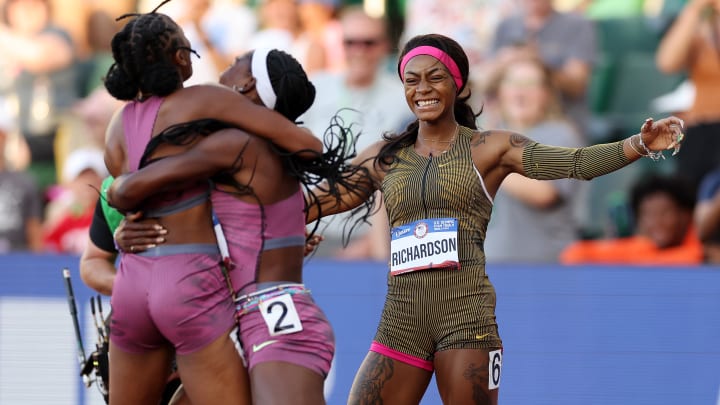Gail Devers Q&A: It's 'Show-Out Time' for Sha’Carri Richardson, Team USA at Paris Olympics

Gail Devers’s story is too remarkable to fit into a single introductory paragraph. The fastest version: elite Olympian comes down with unknown health condition, struggles at the 1988 Seoul Games, drops 79 pounds, nearly loses a foot; is diagnosed with Graves’ disease, embarks on stunning comeback, competes in two more Olympics (five total), wins three gold medals; becomes the subject of a TV movie, Run For the Dream: The Gail Devers Story.
Sha’Carri Richardson is favored to win the 100 meters Saturday. The last American woman to win the 100 meters at the Olympics? Gail Devers, at the 1996 Atlanta Games. SI spoke with Devers about the 100-meter dash, Team USA and what she’s up to now, at 53.
(This interview has been edited for length and clarity.)
Sports Illustrated: You’re the last American woman to win the 100-meter Olympic final, which you did twice, in 1992 and again in ’96. When you won that night in Atlanta, did you ever think we’d still be waiting for another you, in 2024?
Gail Devers: Man, that’s like 28 years ago. That was not my concern at all. I volunteer as a coach at a local high school. The kids are texting about all these things. Like, Gail, someone just broke your 24-year-old Olympic record [in the 100-meter hurdles]. I’m like, I didn’t know I had it, so OK! It’s the same thing with bringing back the gold. I think this year, more than any other, we’ve sent a great team to Paris. If this is the year, it’s going to be a joyous time.
SI: This team is strong, no?
GD: The U.S. team is one of the hardest teams to make. The best example is the 100-meter hurdles final [at U.S. trials] alone. Our fourth- and fifth-place runners [Nia Ali and Tonea Marshall, respectively, who both ran season-best times] could make the Olympic final. And they’re sitting at home.
SI: Curious as to your thoughts on Sha’Carri Richardson. Can she join you in Olympic 100-meter lore?
GD: It’s hard to pick. Let’s go back to trials and see who made the team. First of all, they’re young. It’s their first Olympic games. That makes you hungry. And the three that made the team [Richardson, Melissa Jefferson and Twanisha Terry] are from the same camp. They have the same coach [Dennis Mitchell]. Now, it’s show-out time. If you watch Sha’Carri, all of them, practice, they all show up. She’s certainly capable. Now, it’s forget about those five rings. It’s the same thing we do every day, on the track—execute what you’ve been taught.
SI: In terms of now vs. your first Olympics in 1988, what’s different for those sprinters?
GD: Everything was different—translating, transportation, hotels, training. But that’s what progress is. You want each generation to get better and better. Now, we have the Diamond League. Back then, we didn’t have meets in the states. So you had to go to Europe. We’re all riding the bus together, riding on planes together, riding on the trains.
SI: That’s where your personal story took quite a turn. What stands out, looking back?
GD: That was when I should have been on top of the world. And I was, for a moment, because I had broken the American record for the 100-meter hurdles, in college. The statisticians are saying, If she just runs what she ran a couple months, we’re gonna have a medal. And then I got to the Games and the bottom fell out. I ran slower than I ever ran. There was a problem. It took three years before I was ever diagnosed. I was constantly losing weight, tired all the time, couldn’t sleep. I had problems with my eyes, bulging eye pain. As an athlete, you know your body, and you’re like, Something’s not right. Finally, I got diagnosed. Grave’s disease is an auto-immune disease that causes hyper-thyroidism. Two years later, I came back, and I won my first Olympic gold medal. And then the other shoe dropped.
SI: What happened?
GD: I was still having problems, throughout that whole ordeal, with my eyes. Running over hurdles, everything was blurry. I could never see the hurdles clearly. I had learned to negotiate going over those hurdles. What the rhythm is. That there’s eight steps from the blocks to the first hurdle. That there’s three steps in between. Five steps off the last hurdle to the finish line. But I don’t want to run in rhythm. Because if I’m running in rhythm, I’m running like everybody else. I want to sprint and take those hurdles. I thought it was the residual effect of the Grave’s. But three decades later, I was having problems. I stopped driving at night. The lights coming at me were blinding. After three decades, I found out my eye problems were from a separate-but-related condition called Thyroid Eye Disease. I call him TED, because if somebody’s been living with you for 30 years, he deserves a name. I had to become that voice, hope, advocate for other people.
SI: What do you hope modern sprinters/hurdlers take from your story?
GD: Take care of your body—and I mean beyond getting ready for races. Go to doctors. Find a TED specialist. Think long-term. Go and find a specialist and ask for a comprehensive exam. … Don’t take the marathon route with healthcare. If you know better, do better. I hope my story gives people belief and hope. When [doctors considered amputating her foot], I’m like, OK, you’re going to take my foot. You’re not going to take my joy.
SI: And now, in addition to coaching, you have a foundation?
GD: My dad always said I was a force to be reckoned with. So we have the Gale Force Foundation [also listed online as the Gail Devers Foundation, Inc.]. If I look back at my life, I’m a teacher. Now, the world is my classroom.
SI: No wonder you don’t remember your own records. You’re out kicking TED’s ass.
GD: That’s the plan.
